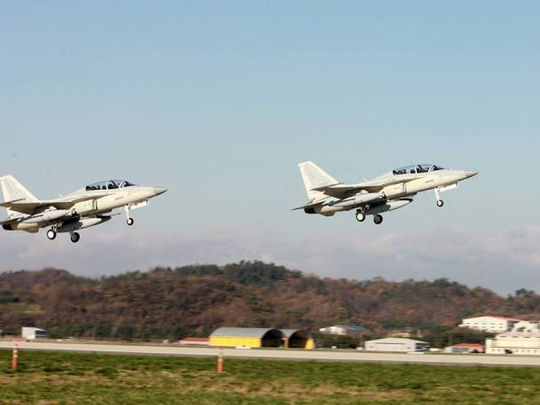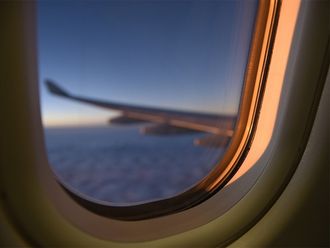
Clark Airbase, Philippines: The Philippines on Saturday received delivery on two Korean-made fighter jets — the country’s first supersonic combat aircraft in a decade — as it strengthens its underfunded military amid an escalating territorial feud with China.
Amid applause from Philippine defence officials, the FA-50 jets touched down at Clark Freeport, a former US Air Force base north of Manila, where fire trucks sprayed water as a traditional welcome salute for the still-unarmed aircraft.
The Philippines bought 12 FA-50s, which are primarily trainer jets that the military converted to also serve as multi-role combat aircraft, from Korea Aerospace Industries at a cost of 18.9 billion pesos (Dh1.47 billion or $402 million). The other jets will be delivered in batches through 2017.
Weapons that include bombs and rockets for the FA-50s will be purchased later.
“We’re glad we’re finally back to the supersonic age,” Defence Secretary Voltaire Gazmin said.
The Philippine military decommissioned its last fleet of supersonic combat aircraft, the F-5, in 2005. A military modernisation program that included plans for the purchase of at least a squadron of fighter jets and naval frigates didn’t happen for several years largely because of a lack of funds.
Over the years, the military has deteriorated to become one of Asia’s weakest.
Under current President Benigno Aquino III, however, territorial spats with China over islands in the South China Sea have escalated and resulted in the Chinese seizure of a disputed shoal in 2012, prompting the military to scramble to acquire new navy ships and air force planes with the help of the United States, the Philippines’ longtime defence treaty ally.
Last week, Aquino authorised Gazmin to enter into major contracts to acquire 44 billion pesos ($936 million) worth of military hardware, including two frigates, anti-submarine helicopters and amphibious assault vehicles for the navy, and long-range patrol aircraft, munitions for the FA-50s and surveillance radar for the air force, Defence Undersecretary Fernando Manalo said.
The new ships, aircraft and military equipment were expected to be purchased from this year up to 2018, according to Manalo.
Lt. Col. Rolando Condrad Pena III, one of three Filipino air force pilots who received training in Korea to fly the FA-50s, said that the jets could carry enough munitions payload and could be used in air-to-air and air-to-ground combat.
“Now that we have a supersonic aircraft our reaction time will be faster,” Pena told reporters.
Still, the Philippines has ruled out a military solution to the territorial conflicts with its limited defence capabilities. In January 2013, the Philippines brought its disputes with China to international arbitration, but Beijing refused to participate and pressed for one-on-one negotiations.
An international tribunal in The Hague, however, dismissed China’s legal arguments last month and ruled that it has authority to hear the Philippines’ case. It said it expects to hand down a decision next year on several issues raised by the Philippines, including the validity of China’s sweeping territorial claims under the 1982 United Nations Convention on the Law of the Sea.












